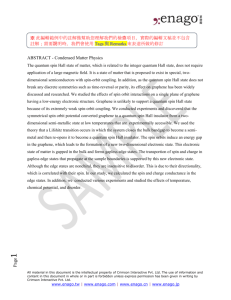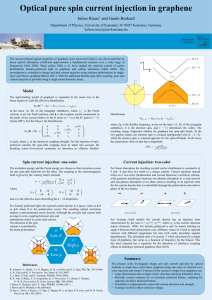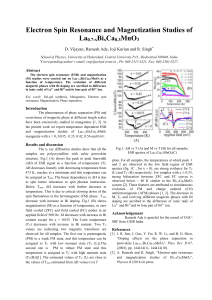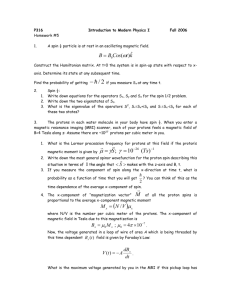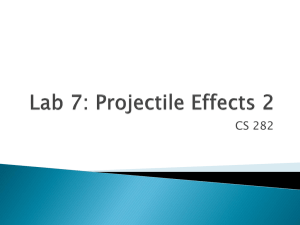Supplementary Materials
advertisement
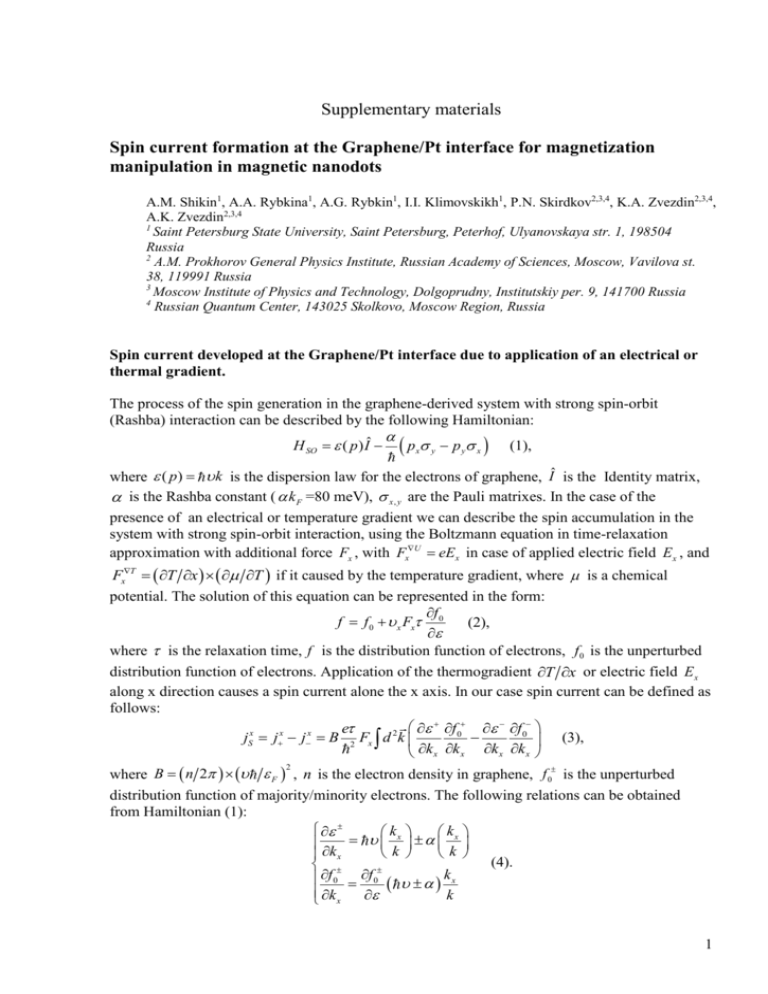
Supplementary materials Spin current formation at the Graphene/Pt interface for magnetization manipulation in magnetic nanodots A.M. Shikin1, A.A. Rybkina1, A.G. Rybkin1, I.I. Klimovskikh1, P.N. Skirdkov2,3,4, K.A. Zvezdin2,3,4, A.K. Zvezdin2,3,4 1 Saint Petersburg State University, Saint Petersburg, Peterhof, Ulyanovskaya str. 1, 198504 Russia 2 A.M. Prokhorov General Physics Institute, Russian Academy of Sciences, Moscow, Vavilova st. 38, 119991 Russia 3 Moscow Institute of Physics and Technology, Dolgoprudny, Institutskiy per. 9, 141700 Russia 4 Russian Quantum Center, 143025 Skolkovo, Moscow Region, Russia Spin current developed at the Graphene/Pt interface due to application of an electrical or thermal gradient. The process of the spin generation in the graphene-derived system with strong spin-orbit (Rashba) interaction can be described by the following Hamiltonian: H SO ( p ) Iˆ px y p y x (1), where ( p) k is the dispersion law for the electrons of graphene, Iˆ is the Identity matrix, is the Rashba constant ( k F =80 meV), x , y are the Pauli matrixes. In the case of the presence of an electrical or temperature gradient we can describe the spin accumulation in the system with strong spin-orbit interaction, using the Boltzmann equation in time-relaxation approximation with additional force Fx , with FxU eEx in case of applied electric field Ex , and FxT T x T if it caused by the temperature gradient, where is a chemical potential. The solution of this equation can be represented in the form: f f f 0 x Fx 0 (2), where is the relaxation time, f is the distribution function of electrons, f 0 is the unperturbed distribution function of electrons. Application of the thermogradient T x or electric field Ex along x direction causes a spin current alone the x axis. In our case spin current can be defined as follows: e f 0 x x x 2 f 0 jS j j B 2 Fx d k (3), k x k x k x k x where B n 2 F , n is the electron density in graphene, f 0 is the unperturbed distribution function of majority/minority electrons. The following relations can be obtained from Hamiltonian (1): kx kx k k k x (4). f 0 f 0 k x k x k 2 1 Using the relations (4), the spin current in case of the electrical field can be rewritten as: 2 x 2 jSx j Ex (5), e where is the graphene conductivity, jex is the electric current along the x-axis. In case of the thermogradient the spin current can be rewritten as: 2 x 2 T jSx je S (6), x en 2 where S is the Seebeck constant. F T In addition to the spin current, under application of the electric field Ex or the temperature gradient T x along x direction an uncompensated density spin appears in the y direction (because the spin of electron in the Rashba model is locked perpendicular to the momentum). The spin accumulation B d 2 k f f ey , where e y is the unit vector along the y-axis, after substitution of (2) can be transformed to the following form: n F (7). x z 0 and y F x Substituting the expression of Fx for the cases of thermogradient and applied electric field, we can obtain spin accumulation in following form: ne T U T S y Ex and y (8). 2 e x F Application of the Graphene/Pt interface for the magnetization dynamics of the (Ni-Fe)nanodots array due to spin-orbit torque effect. Spin current in Graphene/Pt plane enters to the NiFe contact and affects the effective magnetic field in NiFe. Effective Hamiltonian in this case can be described as: H ( p) H R JM 0 (9), where M 0 M M S is the unit vector along the magnetization direction. The last term is related to the induced magnetic field, is the uncompensated spin, M S is the saturation magnetization of magnetic material, J is the exchange integral. The second (Rashba) term H R k z0 leads to the appearance of the effective magnetic field BSO : kF J BSO P je z 0 j 0 , where j 0 =1, P (10). e M S F This additional effective field leads to appearance of the spin torque, acting on magnetization in NiFe layer. Corresponding spin torque per unit volume is given by: kF k TSO M BSO Pje M j 0 F Pje M 0 j 0 (11). e M S e 2

